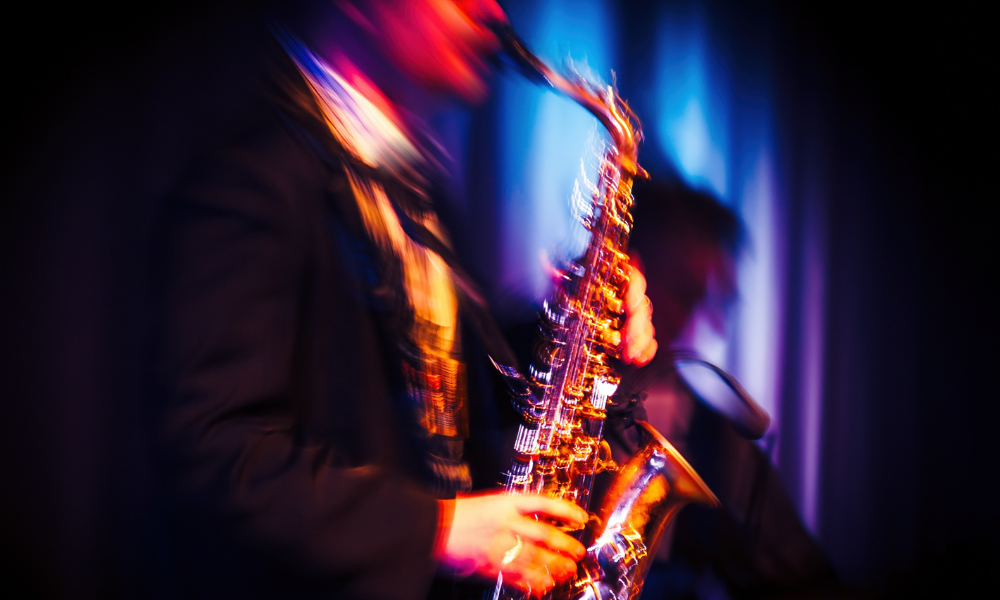You don’t need to be a musician to appreciate jazz. This genre has evolved over the last century, weaving through different styles and cultures while maintaining its rich improvisational essence. In the twenty-first century, jazz continues to captivate audiences worldwide.
Organizations like Jazz Aspen Snowmass (JAS) play a critical role in preserving and celebrating jazz and ensuring its legacy continues for future generations. With the highly anticipated JAS Center set to open later this year, there has never been a more exciting time for jazz lovers to immerse themselves in this timeless art form.
The Birth of Jazz: The Jazz Age
Where Did Jazz Originate?
Jazz’s birthplace is considered New Orleans. It emerged in the early 20th century from the depth of African American musical traditions. The city’s cultural melting pot, filled with diverse musical influences, allowed jazz to develop into a unique and revolutionary sound that spread across the country and beyond.
Who Invented Jazz and How Was Its Sound Created?
It’s impossible to credit a single person with inventing jazz. However, we can thank some of the world’s most legendary musicians, such as Buddy Bolden, Louis Armstrong, and Jelly Roll Morton, for shaping its early development. Jazz was built on improvisation, syncopated rhythms, and expressive melodies that captivated audiences and spoke to the mood of the time it was created.
How Different Genres of Jazz Developed
Early Jazz
The earliest forms of jazz are known as Dixieland or traditional jazz. These are characterized by collective improvisation and lively brass instrumentation. New Orleans was the epicenter. From there, artists brought the sound to cities like Chicago and New York.
Swing and Big Band
By the 1930s and 1940s, jazz had transformed into swing, an upbeat style dominated by big bands led by icons like Duke Ellington and Benny Goodman. Swing music brought jazz to dance halls, making it the soundtrack of the World War II era and a defining element of American culture.
Bebop
The 1940s also saw the emergence of bebop, a complex and fast-paced style pioneered by Charlie Parker, Dizzy Gillespie, and Thelonious Monk. Unlike swing, bebop was meant for attentive listening, not dancing. This move pushed jazz from being popular into a more intricate and intellectual space.
Cool Jazz
In contrast to bebop’s high-energy approach, cool jazz emerged in the late 1940s and 1950s, offering a more relaxed and smooth sound. Artists like Miles Davis and Chet Baker helped define this subgenre with their lyrical and subdued playing styles.
Hard Bop, Modal Jazz, and Latin Jazz
The 1950s and 1960s introduced hard bop, which infused blues and gospel influences into jazz, and modal jazz, which focused on improvisation within musical modes rather than chord progressions. Latin jazz, led by figures like Tito Puente, blended Afro-Cuban rhythms with jazz harmonies, adding a rich percussive element to the genre.
Fusion Jazz
By the late 1960s and 1970s, jazz began merging with rock and electronic elements, giving rise to fusion jazz. Artists Herbie Hancock and Weather Report incorporated synthesizers and electric instruments to match other genres of the day, expanding jazz’s influence.
Modern Jazz
As culture evolves, so does jazz. Today, it incorporates everything from hip-hop to electronic music. Contemporary artists like Kamasi Washington and Esperanza Spalding keep jazz modern while honoring its deep historical roots.
Jazz in Today’s World
Jazz’s survival depends on dedicated organizations and passionate musicians who recognize its cultural importance. JAS is at the forefront of this movement, offering performance opportunities, educational programs, and world-class festivals that keep jazz alive.
The upcoming JAS Center will open later this year and will be a hub for jazz enthusiasts. Audiences can embrace new talent and legendary artists on one stage. Supporting initiatives like JAS ensures that jazz remains a vibrant and essential part of our musical heritage.
See World-Class Jazz Performances
There’s no better way to experience jazz than through live performances. JAS hosts premier events, including the JAS June Experience, where music lovers can witness the magic of jazz live on stage in a breathtaking setting.
The JAS Center above the historic Red Onion is another exciting option for jazz lovers to keep their eye on, as it will provide them with another world-class venue to enjoy and is scheduled to be completed later this year.
Whether you’re a lifelong jazz fan or new to the genre, JAS provides an unparalleled opportunity to celebrate and support this ever-evolving art form. Contact us to learn more!
Image Credit: Drop of Light // Shutterstock


